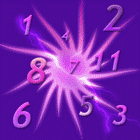|
Numerology Index:-

Numerology is any of many systems, traditions or beliefs in a mystical or
esoteric relationship between numbers and physical objects or living things.
Numerology and numerological divination were popular among early
mathematicians, such as Pythagoras, but are no longer considered part of
mathematics and are regarded as pseudomathematics by most scientists. This is
similar to the historical development of astronomy out of astrology, and
chemistry from alchemy.
Today, numerology is often associated with the occult, alongside astrology
and similar divinatory arts. The term can also be used for those who, in the
view of some observers, place excess faith in numerical patterns, even if those
people don't practice traditional numerology. For example, Underwood Dudley uses
the term to discuss practitioners of the Elliott wave principle of stock market
analysis.
The roots of numerology can be traced back some 10,000 years or more to Egypt
and Babylonia. Pythagoras, who developed many of the basic theorems that form
the foundation of modern mathematics (including the right triangle theorem
taught in math classes today) is credited with formally organizing the field
about 2600 years ago in ancient Greece. At the turn of the twentieth century, an
American woman, L. Dow Balliet, and several of her contemporaries published a
few books and started the modern phase of numerology. The field grew slowly
through several decades. Now, in the last half of the century, increased
research and publishing along with a marked resurgence of interest in numerology
is taking place.
Everything in the universe vibrates at its own particular frequency. By
finding the vibration rate of any object, you can establish the qualities and
energies associated with it. By applying the principles of numerology-and using
only the name and birth date as the basic data-you can determine the major
frequencies of different people. A numerological analysis of the calculated
frequencies provides significant information on these people's personalities and
character.
In the basic mathematical operation used in numerology, the numbers are
reduced by simple addition. The number 15, for instance, is reduced by adding 1
+ 5 to get 6. Similarly, the number 1974 can be reduced by adding 1 + 9 + 7 + 4
to get 21. The 21 can be further reduced by adding 2 + 1 to get 3.
In numerology, all numbers are reduced to the single digits 1 through 9
except the special master numbers 11 and 22. 1, 2, 3, 4, 5, 6, 7, 8, 9, 11 and
22 represent the major vibration rates associated with people's characteristics.
Letters in individuals' names are converted to numbers and then added
together. These numbers, in turn, are also reduced. The letter A, for instance,
is 1; the letter B is 2; the letter C is 3, and so forth. The following table
shows the numbers assigned to all 26 letters in the English alphabet.
1 2 3 4 5 6 7 8 9
A B C D E F G H I
J K L M N O P Q R
S T U V W X Y Z
By applying simple mathematical formulas to the numbers representing a
person's name and birth date, a numerologist can derive four major core elements
and some twenty or thirty modifiers. A symbolic evaluation of these elements and
modifiers provides a remarkably complete and accurate character analysis. (About
half the information in the analysis, incidentally, comes from the birth date
and half from the name.)
|
